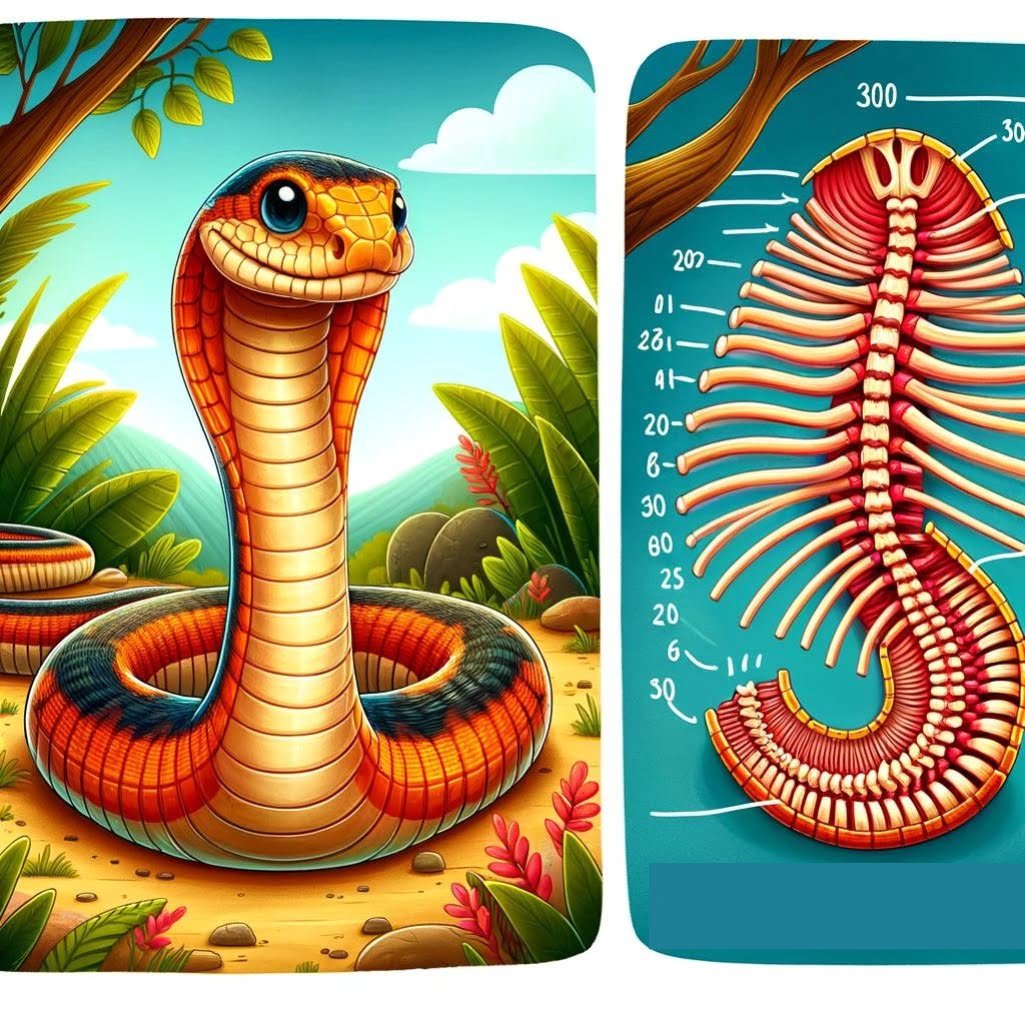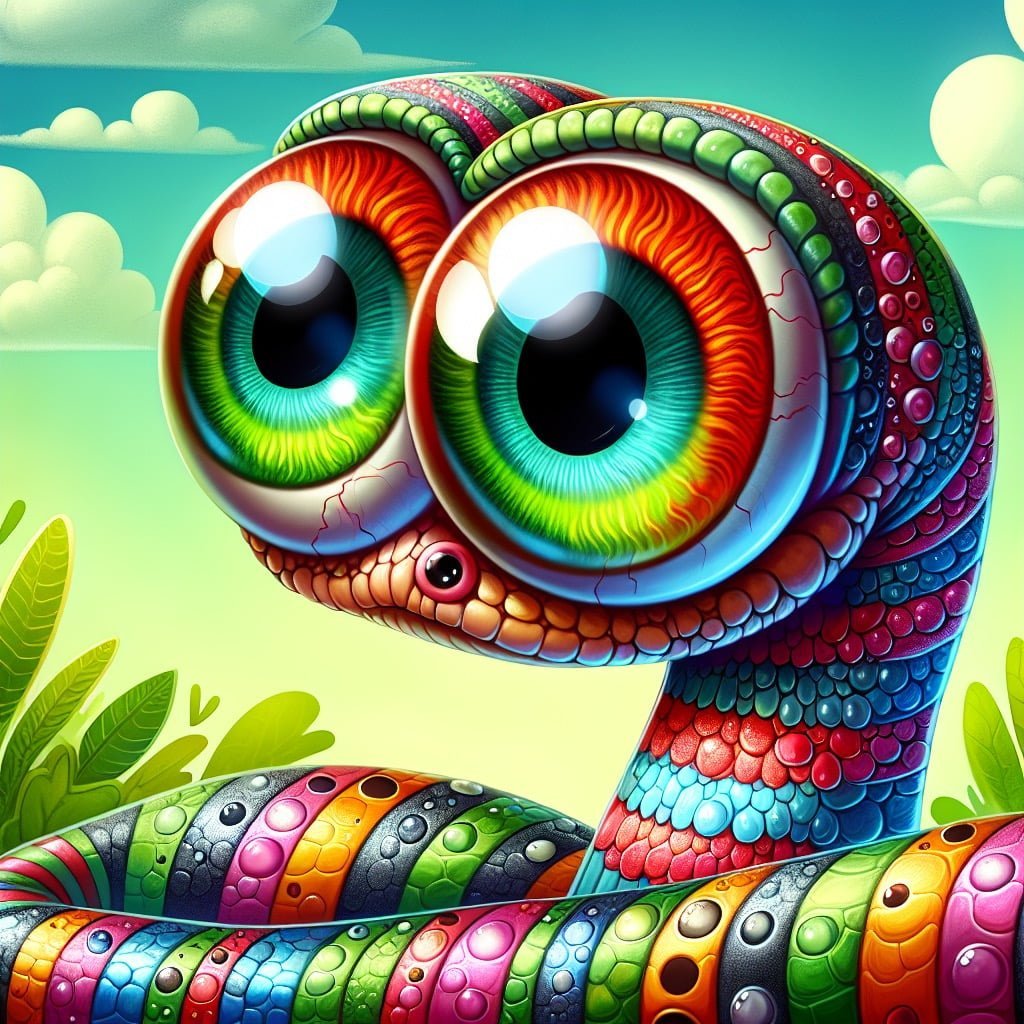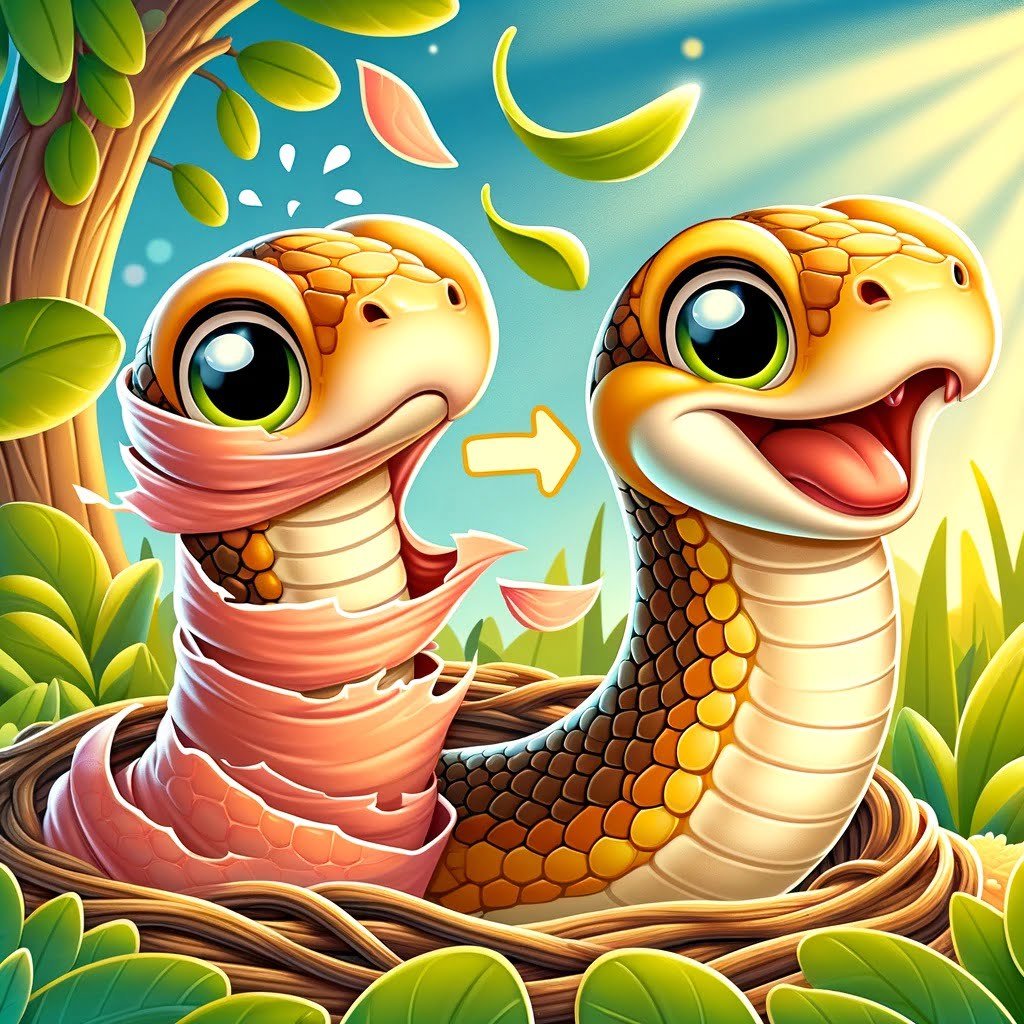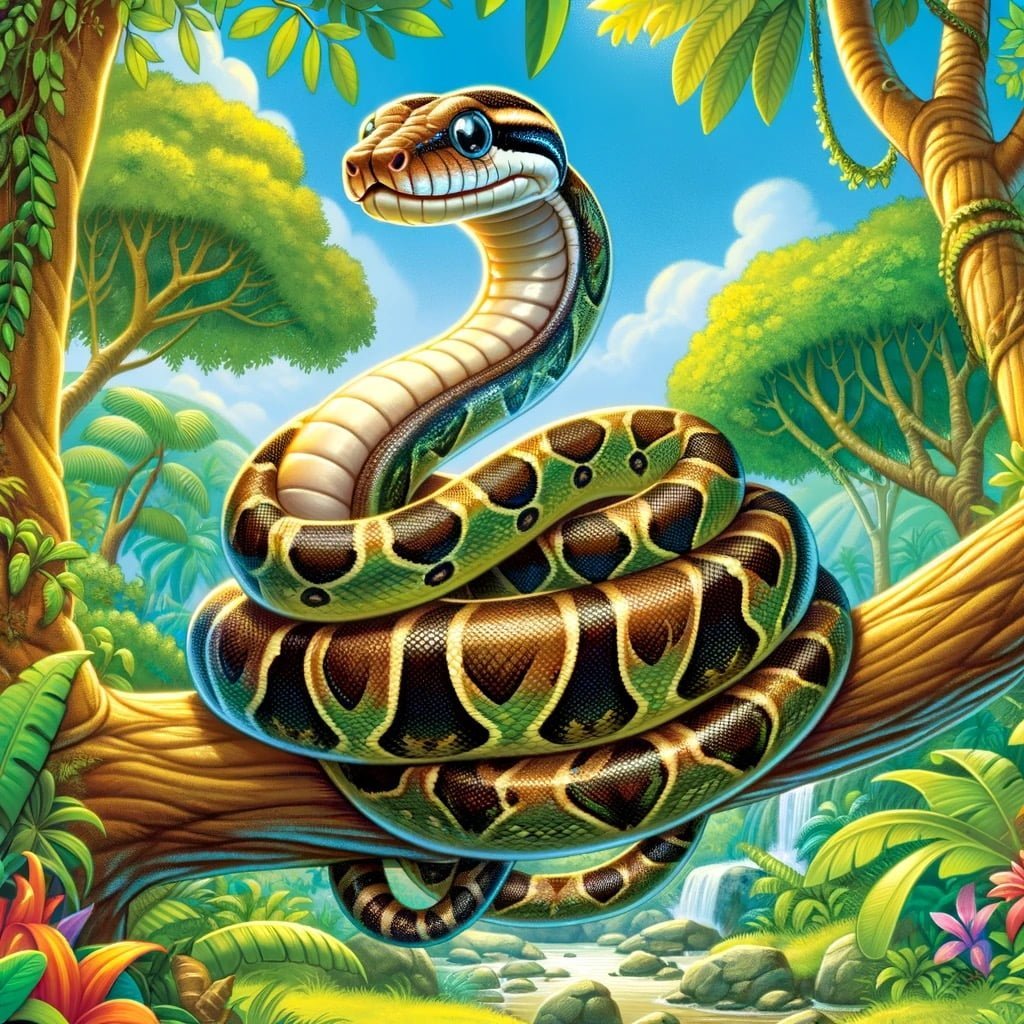Welcome to an exciting collection of Snake Facts For Kids! From the incredible number of ribs they have to their unique hunting abilities, these fascinating reptiles are sure to capture your imagination. Whether you’re a younger child learning about snakes for the first time or an older kid delving into more intricate details, there’s something here for everyone. Discover why snakes don’t have eyelids, how some species can see in infrared, and the astonishing size and speed of snakes like the black mamba and anacondas. Get ready to be amazed by the world of snakes and their extraordinary traits. Join us on this fascinating journey into the realm of these slithery creatures and unlock the secrets of the serpent world!
Snake Facts For Kids
1. Snakes Have Many Ribs, Up to 300!

For younger kids: Snakes have lots of ribs to help them move and protect their bodies.
For older kids: Snakes can have as many as 300 pairs of ribs, which give their bodies flexibility for crawling and sliding through various terrains.
Detailed explanation:Snakes are fascinating creatures that have captured the curiosity of kids and adults alike for centuries. One interesting fact about snakes that often surprises people is that they have a large number of ribs, with some species having up to 300 ribs. These ribs are not like our own, which are connected to the breastbone. Instead, snake ribs are loosely attached to the spine, allowing for the flexibility and agility that snakes are known for.
The sheer number of ribs in snakes is one of the reasons they are able to move in such a graceful and sinuous manner. Each rib is connected to a pair of muscles that allow the snake to lift and push off the ground as it slithers along. This unique skeletal structure also enables snakes to swallow prey much larger than the size of their own head, as their ribs can expand and stretch to accommodate large meals.
In addition to their ribs, snakes also have a highly specialized skull structure that allows them to dislocate their jaws in order to swallow prey whole. This, combined with their flexible ribcage, makes snakes incredibly efficient predators in their natural habitats.
Learning about snake facts can be an exciting and educational experience for kids, helping them to appreciate the diversity and complexity of the natural world. By understanding the unique features of snakes, children can develop a sense of wonder and respect for these amazing reptiles. So, the next time you come across a snake, remember that their many ribs are just one of the many fascinating adaptations that make them such incredible creatures.
Snake Facts For Kids
2. Snakes Can Swallow Prey Bigger Than Their Heads

For younger kids: Snakes can eat really big animals by stretching their jaws wide!
For older kids: Snakes have an incredible ability to open their jaws wide to consume prey larger than the size of their heads due to their flexible ligaments and skull structure.
Detailed explanation:When it comes to snake facts for kids, one of the most fascinating abilities that snakes possess is their amazing capability to swallow prey that is larger than their own heads. This is possible due to their incredibly flexible jaws, which are connected by ligaments instead of being fused together like human jaws. This unique jaw structure allows snakes to open their mouths incredibly wide, enabling them to consume prey that may seem impossible given the size of their head.
Snakes have several adaptations that help them swallow large prey. Firstly, their lower jaws are not connected in the front, allowing them to open their mouths wider than most other animals. Additionally, snakes have stretchy skin and highly elastic muscles, which enable them to expand their bodies to accommodate larger prey. Some snakes even have specialized teeth that point backwards, helping them grip onto their prey and maneuver it into their mouths.
Once a snake has captured its prey, it will use its powerful muscles to push the food down its throat. Because snakes lack the ability to chew their food, they rely on strong stomach acids to break down their meal for digestion. This process can take several days, during which time the snake will often find a hidden spot to rest and wait for its prey to be fully digested.
Overall, the fact that snakes can swallow prey larger than their heads is a testament to their incredible anatomical adaptations and unique feeding strategies. This ability not only allows snakes to survive in their natural habitats, but also serves as a captivating point of interest for kids learning about these fascinating creatures.
Snake Facts For Kids
3. Some Snakes Have Infrared Vision

For younger kids: Some snakes can see in special colors that help them find food!
For older kids: Certain snake species possess infrared vision, which allows them to detect the heat emitted by their prey, making hunting easier in low light or complete darkness.
Detailed explanation:Snakes are fascinating creatures with a variety of unique adaptations, one of which is their ability to see in infrared. This means that some snakes have the remarkable ability to detect heat signatures emitted by their prey, allowing them to hunt effectively even in complete darkness. This infrared vision is particularly useful for snakes that are nocturnal or live in low-light environments, as it gives them a significant advantage when locating warm-blooded animals such as rodents or birds.
The way in which snakes see in infrared is quite different from how humans or other animals perceive the world. Instead of relying on traditional visual cues like colors or shapes, snakes use special organs called pit organs to detect infrared radiation. These pit organs are located on the sides of the snake’s head and contain heat-sensitive receptors that can detect even the slightest temperature differences in their surroundings. When a warm-blooded animal passes by, the snake’s pit organs pick up on the heat emitted by the animal’s body, allowing the snake to accurately pinpoint its location.
This unique adaptation is just one of the many reasons why snakes are such successful predators in their ecosystems. By being able to see in infrared, snakes have evolved to be highly efficient hunters, capable of detecting and capturing their prey with incredible accuracy. For kids who are interested in learning more about these fascinating creatures, exploring snake facts for kids can provide a wealth of information about the incredible adaptations that make snakes such formidable predators in the animal kingdom.
Snake Facts For Kids
4. Snakes Don’t Have Eyelids

For younger kids: Snakes’ eyes are always open because they don’t have eyelids.
For older kids: Unlike humans, snakes lack eyelids; instead, they have a clear protective scale over their eyes that keeps them moist and shields them from dirt.
Detailed explanation:Snakes are fascinating creatures that have many unique characteristics, one of which is the fact that they don’t have eyelids. Unlike most other animals, snakes do not have movable eyelids to protect their eyes. Instead, they have a clear scale over each eye called a spectacle or brille. This scale is similar to a contact lens and helps to protect the eye from dust, debris, and moisture.
Having no eyelids might seem like a disadvantage, but snakes have evolved other clever adaptations to protect their eyes. One of these adaptations is their ability to shed their skin, including the clear scale over their eyes. This process, known as ecdysis, allows snakes to periodically replace damaged or dirty eye scales with a new, clean one.
Another interesting feature of snake eyes is their unique shape. Most snakes have round pupils, although some species, such as vipers, have vertical slit pupils. These pupils can dilate and contract to control the amount of light entering the eye, allowing snakes to see well in both bright and dim conditions.
In addition to their eye scales and pupil adaptations, snakes also have excellent vision. Many species of snakes have good eyesight and can detect movement from a distance. Some snakes even have specialized pits near their eyes called loreal pits, which allow them to sense heat and detect prey through infrared radiation.
In conclusion, the fact that snakes don’t have eyelids is just one of many fascinating aspects of these incredible creatures. Their unique eye scales, pupil shape, and visual adaptations make them well-suited to their environment and hunting habits. By understanding these Snake Facts For Kids, we can appreciate and admire the remarkable abilities of snakes even more.
Snake Facts For Kids
5. Snakes Shed Their Skin Regularly

For younger kids: Snakes shed their skin to help them grow big and stay healthy!
For older kids: Snakes undergo the process of shedding their skin, called ecdysis, to accommodate their increasing body size, heal wounds, and remove parasites or old scales.
Detailed explanation:Snakes, fascinating creatures that they are, have a unique way of growing as they age – they shed their skin regularly. This process, known as ecdysis, is essential for snakes as it allows them to get rid of old and worn-out skin in order to make way for new skin to grow.
So, why do snakes shed their skin? Well, snakes do not have the luxury of shedding skin cells like we humans do. Instead, their skin stretches as they grow, which eventually becomes too tight for them. In order to accommodate their increasing size, snakes must shed their skin to allow for new skin cells to be produced. This process typically occurs anywhere from a few times a year to once every few months, depending on the age and species of the snake.
During the shedding process, snakes become more irritable and exhibit changes in behavior. This is because the outer layer of their skin, known as the epidermis, separates from the underlying layer, revealing a new layer of skin underneath. The snake will then rub against rough surfaces to help loosen the old skin and eventually slough it off completely.
For kids who are interested in learning about snakes, understanding why they shed their skin can be a fascinating topic of discussion. It showcases how snakes adapt to their environment and how their bodies are uniquely designed to facilitate growth and development. Ultimately, the shedding of skin in snakes is a natural and necessary process that allows them to thrive in their habitats.
Snake Facts For Kids
6. The Fastest Snake is the Black Mamba

For younger kids: The black mamba snake is super fast and can outrun most animals!
For older kids: The black mamba is known for its remarkable speed, capable of reaching up to 12.5 miles per hour and swiftly covering distances to hunt or escape predators.
Detailed explanation:The Black Mamba, known for its speed and agility, holds the title of the fastest snake in the world. This remarkable snake species can reach speeds of up to 12 miles per hour when in pursuit of prey or when feeling threatened. The Black Mamba’s exceptional speed is a result of its long, slender body and powerful muscles, which allow it to move swiftly across various terrains.
One interesting feature of the Black Mamba is its ability to raise one-third of its body off the ground while in motion, giving it a unique and intimidating appearance. This skill also helps the snake to navigate through dense vegetation and quickly escape predators.
Despite its impressive speed, the Black Mamba is not known for actively chasing down its prey. Instead, it relies on stealth and ambush tactics to catch small mammals, birds, and other animals. Once it has located its target, the Black Mamba will strike quickly and deliver a potent neurotoxic venom, which can be fatal to its prey within a matter of hours.
Snake Facts For Kids highlight the importance of understanding and respecting these fascinating creatures. While the Black Mamba may be the fastest snake in the world, it plays a crucial role in its ecosystem by helping to control populations of rodents and other pests. By learning about snakes and their behaviors, we can better appreciate the diversity of life on our planet. Overall, the Black Mamba’s incredible speed and hunting strategies make it a truly impressive and awe-inspiring species.
Snake Facts For Kids
7. Anacondas Are Some of the Largest Snakes

For younger kids: Anacondas are one of the biggest snakes in the world – so huge and strong!
For older kids: Anacondas are among the largest snake species, with some individuals growing over 29 feet long and weighing more than 550 pounds, making them formidable predators in their habitat.
Detailed explanation:Anacondas are some of the largest snakes in the world, belonging to the genus Eunectes. These massive reptiles can grow up to an astonishing length of 30 feet and weigh as much as 550 pounds. They are mainly found in the rainforests of South America, particularly in the Amazon River basin.
One of the most fascinating aspects of anacondas is their incredible ability to swim and hunt in water. They are excellent swimmers and can travel long distances through rivers and swamps in search of prey. Despite their large size, they are surprisingly agile in the water, using their muscular bodies to navigate effortlessly through the dense vegetation.
Anacondas are constrictors, which means they squeeze their prey to death before swallowing it whole. Their diet mainly consists of large mammals, birds, and even fish. Due to their size and predatory nature, anacondas are often feared by humans, although they typically avoid confrontation unless provoked.
In addition to their impressive size, anacondas are also known for their unique reproductive habits. Female anacondas give birth to live young instead of laying eggs like most other snake species. This is a rare phenomenon in the animal kingdom and adds to the mystique surrounding these captivating creatures.
Learning about anacondas can be a thrilling experience for children interested in Snake Facts For Kids. Their enormous size, aquatic prowess, and fascinating reproductive behavior make them a captivating subject of study and a truly remarkable species in the world of snakes.
Snake Facts For Kids
8. Some Snakes Can Spit Venom

For younger kids: Some snakes can spit their venom to protect themselves from danger!
For older kids: Certain snake species like the spitting cobra can accurately aim and spray their venom as a defense mechanism, reaching distances of up to 8 feet to deter predators or threats.
Detailed explanation:Snake Facts For Kids can be fascinating and sometimes a bit unsettling, especially when you learn that some snakes have the ability to spit venom. This behavior is most commonly associated with snakes in the Elapidae family, such as cobras and spitting cobras. When these snakes feel threatened, they can forcefully eject venom from their fangs, aiming it towards the eyes of their perceived attacker.
The venom spit by these snakes can cause irritation, pain, and even temporary blindness if it comes into contact with the eyes. This defense mechanism is incredibly effective at deterring predators and giving the snake a chance to escape unharmed.
It’s important to note that not all snakes spit venom, and even those that do may not rely on this defense strategy as their primary means of protection. Spitting venom is a specialized skill that has evolved in certain snake species as a way to defend themselves against potential threats.
In the wild, snakes that can spit venom use this ability sparingly, reserving it for situations where they feel particularly threatened. When interacting with snakes in their natural habitat, it’s crucial to give them the space and respect they deserve to avoid provoking them into using their venom-spitting defense.
Learning about the different behaviors and adaptations of snakes, such as their ability to spit venom, can help foster a greater appreciation for these fascinating creatures and the important role they play in their ecosystems. Snake Facts For Kids offers a wealth of knowledge that can inspire curiosity and awe in young minds.
Snake Facts For Kids
9. Rattlesnakes Warn Before Striking

For younger kids: Rattlesnakes shake their tail to tell others to stay away!
For older kids: Rattlesnakes possess a rattle at the end of their tail, which they shake to produce a warning sound alerting potential threats before striking, serving as a defensive strategy to avoid conflicts.
Detailed explanation:Rattlesnakes are known for their distinctive warning signal before striking, making them fascinating creatures to study in the wild. These unique reptiles have a specialized structure at the end of their tails called a rattle. When a rattlesnake feels threatened or cornered, it will shake its tail rapidly, causing the segments of the rattle to vibrate against each other and produce a loud rattling sound. This serves as a clear warning to potential predators or intruders to stay away.
One interesting aspect of this behavior is that the rattlesnake is actually giving its prey a chance to retreat before launching an attack. This warning signal is a form of communication that helps the snake avoid unnecessary conflict and conserve its energy for hunting and survival. It is a prime example of how animals have evolved various strategies to ensure their own safety and success in the natural world.
For kids who are interested in learning about snakes, understanding the behavior of rattlesnakes can be both educational and exciting. By studying how these reptiles use their rattles as a warning system, children can gain a deeper appreciation for the complexity of animal communication and the importance of respecting wildlife in their natural habitats. Overall, rattlesnakes serve as a captivating subject for young scientists and nature enthusiasts alike, showcasing the remarkable adaptations that have allowed them to thrive as apex predators in their ecosystems.
Snake Facts For Kids
10. Boa Constrictors Squeeze Their Prey

For younger kids: Boa constrictors give big hugs by squeezing their food very tight!
For older kids: Boa constrictors are known for their hunting method of wrapping their bodies around prey and using powerful muscles to constrict and suffocate them before swallowing whole, demonstrating their extraordinary strength and feeding strategy.
Detailed explanation:Boa constrictors are fascinating creatures that are known for their unique method of hunting – squeezing their prey to death. These snakes are non-venomous, so they rely on their powerful muscles to subdue their victims. When a boa constrictor detects its prey, it will strike quickly and wrap its body around the unfortunate animal, using its muscular strength to constrict or squeeze it tightly.
This method of hunting is highly effective, as the pressure exerted by the snake’s coils restricts the prey’s blood flow, ultimately leading to its death. Boa constrictors are known to be opportunistic feeders, meaning that they will eat a variety of animals, including birds, mammals, and reptiles. Despite their intimidating reputation, boa constrictors are not a threat to humans unless provoked.
It is important for kids to understand the behavior of boa constrictors and other snakes in order to appreciate and respect these animals from a safe distance. Teaching kids about snake facts can help dispel common myths and misconceptions surrounding these creatures. By learning about how snakes hunt and survive in their natural habitats, children can develop a greater understanding and appreciation for the diversity of the animal kingdom.
In conclusion, boa constrictors squeeze their prey as a means of hunting and capturing food. This fascinating behavior showcases the adaptability and efficiency of these remarkable snakes. Snake Facts For Kids can be an educational and engaging way to introduce children to the wonders of the natural world.
Did you know?
Did you know that some snakes can go months without eating a single meal?
Summary of Snake Facts For Kids
Are you fascinated by these slithering creatures? In this engaging blog post, we explore ten intriguing facts about snakes that will captivate readers of all ages. From the surprising number of ribs snakes have (up to 300!) to their amazing ability to swallow prey larger than their heads, there’s so much to learn about these fascinating reptiles. Did you know that some snakes have infrared vision or that they shed their skin regularly? These fun and educational facts are sure to spark your curiosity and deepen your understanding of these incredible creatures. So, whether you’re a younger child keen to learn about snakes’ unique features or an older kid curious about their hunting behaviors, this blog post is a must-read for anyone interested in the captivating world of snakes. Dive in and discover a whole new appreciation for these remarkable animals!
Sources and additional information for Snake Facts For Kids
WikipediaBritannicaSan Diego Zoo KidsThe Smithsonian InstitutionDK Find Out!Australian MuseumWorld Wildlife FundThe Nature ConservancyAnimal PlanetMonterey Bay AquariumPBS NatureSmithsonian’s National Zoo & Conservation Biology InstituteWorld Wildlife FundAnimal Diversity Web (University of Michigan)IUCN Red List of Threatened SpeciesThe Cornell Lab of Ornithology – All About BirdsNational Audubon SocietyEncyclopedia of LifeSeaWorld Parks & EntertainmentAustralian Museum – AnimalsEncyclopedia of Life




